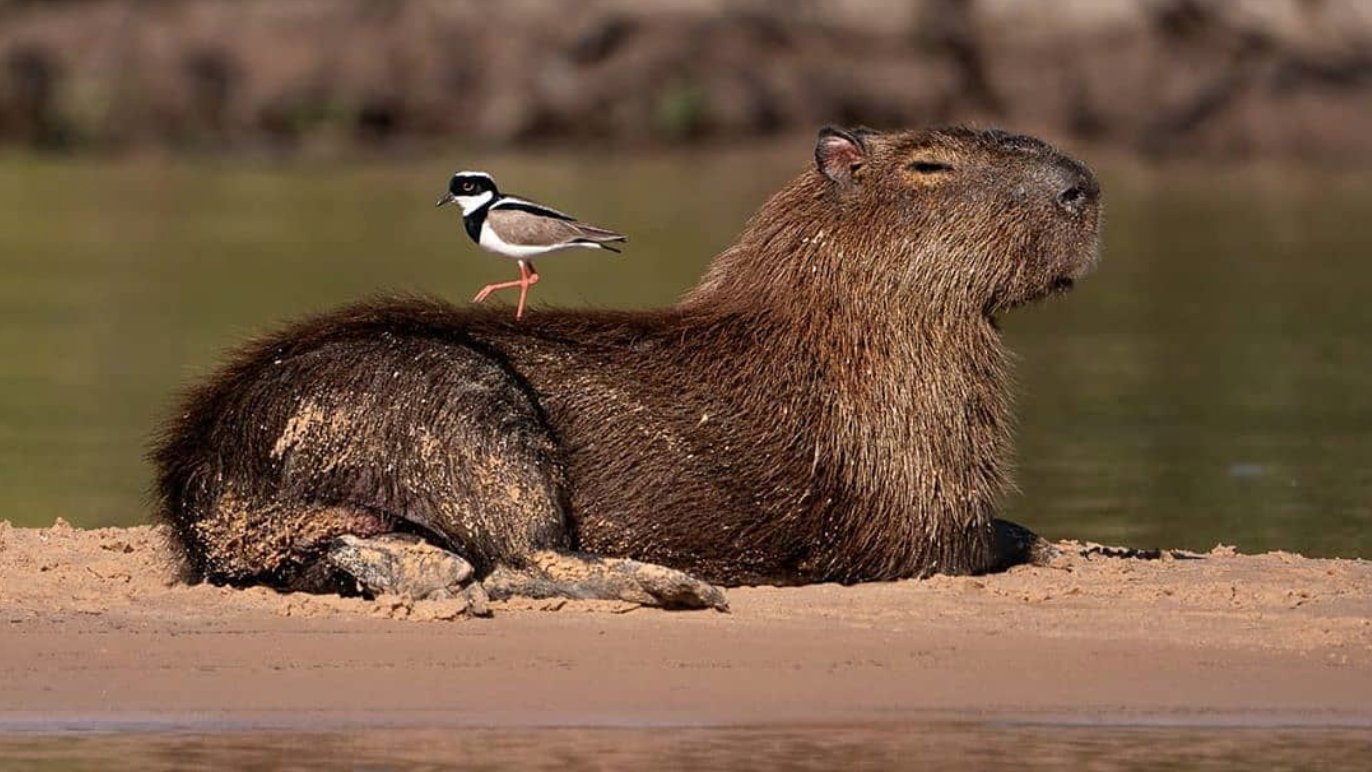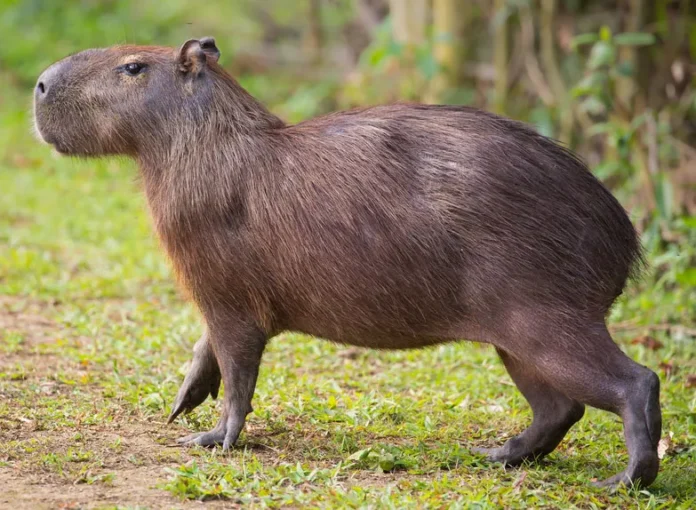Last Updated on February 9, 2024 by Fumipets
Into the World of Capybaras: Nature’s Gentle Giants
Capybaras, the oversized rodents native to South America, have emerged as enchanting and peculiar creatures, captivating the hearts of nature enthusiasts worldwide.
Known as the world’s largest rodents, these semi-aquatic mammals possess a unique charm that goes beyond their sizable appearance. From their fascinating social structures to their remarkable adaptability, capybaras offer a glimpse into a world where nature’s wonders defy expectations.
Join us on an exploration of these gentle giants, delving into their habits, habitats, and the intriguing aspects that make them stand out in the animal kingdom.
Capybaras
Due to its size, the world’s biggest rodent, the capybara, is more difficult to care for than its smaller relative, the guinea pig. In truth, they demand a vast pool of water and require a lot of space. They like to dwell in groups. You may require a license to possess one in certain places, and it may not be permitted to keep capybaras as pets at all in others, so check your local regulations.
They do, however, adore human touch and snuggling with humans as much as any other animal. They may make excellent pets if you can satisfy their housing and food needs (and keeping one as a pet is permissible in your area).
Capybaras In the Wild
The capybara is a semi-aquatic South American animal. These rodents are related to guinea pigs, despite measuring up to 170 pounds. The world’s biggest rodent has a pig-like physique and lives near vast pools of water in woods. They’re well-equipped, with partly webbed feet and fragile hair that dries quickly. They have the ability to hold their breath underwater for up to 5 minutes at a time, which is incredible!
They consume aquatic plants and grasses in the wild. They also consume their own protein-rich morning faeces, and although they may live alone, they prefer to dwell in groups of up to 40 people.
Large creatures, such as jaguars on land and caimans in the water, prey on them. Boa constrictors and birds of prey must also be avoided by young capybara.
/GettyImages-528162130-53d0c5076eb14915ade61b5d3021294f.jpg)
Behavior
The capybara, like its guinea pig relative, may be a caring and devoted companion, although it is generally timid at first. Capybaras are normally docile when they are young, and even if you receive one as an adult, it will warm up to you with time.
Offering your mouse a handful of suitable grass is a fantastic method to develop trust with your new pet, as it is with most animals. Comb them while they’re eating. This will also aid in the formation of a relationship between you two.
This species isn’t renowned for being violent, but they do have sharp, possibly lethal fangs that they’ll use if they feel threatened, so be ready.
Once the capybara has formed a relationship with you, it will seek out cuddles and attention. They will love the companionship of other capybaras in their enclosure and may snuggle other animals.
Vocalization
Capybaras are vocal creatures, whether in the wild or in captivity. To communicate with other capybaras, they make a variety of grunts, whistles, and other sounds. They adore communicating and will make an effort to communicate with you if you leave them alone. In captivity, they should be housed alongside at least one other animal of the same species with whom they can freely converse.
However, the capybara is not a quiet animal, which is something to keep in mind if you’re thinking about getting one as a pet.
Housing
At least 250 square feet is required for a pair of capybaras. This should be a fenced-in area with a covered shelter for usage at night. Because capybaras may leap and climb, make sure the fence surrounding the cage is at least 4 feet high and that it is constantly checked for breaches through which they might escape.
You’ll need a pool of water that’s at least 3 feet deep. Capybaras not only like being in the water, but they also need it in their habitat. Without frequent hydration, their skin would dry up, and some of the water should be kept out of the sun.
Your colossal rodent will love interacting with various goods and toys. Give children toys made of raw wood. These toys will be used to play with and chew on, which will help grind down their continually expanding teeth.
Diet
In the wild, the breed’s diet is monotonous, consisting of just a few plant types. Grass and water plants are their primary sources of food. The capybara will also consume its own faeces in the morning since some of these species are tough to digest. When grass travels through the system, it is not completely digested, so by eating it twice, they ensure that they obtain all of the benefits before it is thrown. It may seem disgusting, but it is a practical manner of using food that is used by many animals.
You may feed Orchard or Timothy hay to your pet in captivity. These may be purchased at pet shops. Gnawing on hay not only offers sustenance for the animal, but it also wears down the teeth.
Because capybaras are prone to scurvy and do not create enough vitamin C in their bodies, you’ll need to feed them a vitamin C-fortified pellet meal. Feed guinea pig pellets and carrots as a reward every now and then.

Health Conditions
Capybaras are tough creatures. They are prone to scurvy, but by providing vitamin C-rich pellets, you should be able to help them prevent it. Capybaras may develop an overbite if they don’t grind their teeth sufficiently, which can lead to facial deformity, so you’ll want to make sure the teeth are appropriately worn down.
Care Requirements
The most important aspect of capybara care is to keep it company. A capybara may survive alone in the wild, but it requires at least one buddy in captivity to chat to, swim with, and groom. However, avoid keeping male couples or male-exclusive groups, and bear in mind that the more animals you have, the more space you’ll require.
Legality
There is a legal issue to consider. Some states may make it unlawful to keep a capybara as a pet. Even in jurisdictions where they are not illegal, certain localities may restrict them. In certain locations, ownership may need a license or permission, however in others, there are no restrictions and it is entirely lawful to possess one. Determine the legal requirements for owning this sort of animal by contacting your local authorities.
Cost
An adult capybara will cost you at least between $1,000 and $3,000. Females are normally more expensive, and at least two of these animals should be kept together. Before you buy a huge rodent, make sure it’s awake and active, doesn’t exhibit any indications of stress, and doesn’t have any evident parasites or infections.
FAQ’S
Are Capybaras Friendly?
Capybaras may be quite friendly. They will befriend one another, and they will often befriend and like snuggling other animals. A domesticated capybara will not only tolerate but also enjoy spending time with its human family. Capybaras in the wild, on the other hand, are wary and reluctant to approach people.

Do They Enjoy Cuddling?
The colossal rodent enjoys cuddling. They prefer to snuggle with other capybaras, but if that is not feasible, they will cuddle with practically any animal. Capybaras are shown snuggling bunnies, dogs, and, of course, humans.
Is a Capybara a Good Pet?
The capybara may be an excellent pet, but they will require their own enclosure, which will be large enough for them to swim in and a deep pool to keep their skin hydrated. This massive rodent adores cuddling, can be domesticated, and enjoys being in the company of humans, other capybaras, and other animals. You should verify local rules before purchasing a capybara as a pet to confirm that keeping one is permissible.
How big do capybaras get?
Capybaras are the largest rodents in the world and can grow to be about 3.5 to 4.5 feet (1.0 to 1.4 meters) in length and weigh between 77 to 146 pounds (35 to 66 kilograms).
Where are capybaras native to?
Capybaras are native to South America, specifically found in countries such as Brazil, Venezuela, Colombia, and Argentina. They are semi-aquatic animals and are commonly found near bodies of water like rivers, lakes, and marshes.
What do capybaras eat?
Capybaras are herbivores, primarily feeding on grasses, aquatic plants, and fruits. They have a specialized digestive system that allows them to efficiently extract nutrients from a plant-based diet.
Are capybaras social animals
Yes, capybaras are highly social animals and live in groups known as “capybara herds.” These herds can consist of 10 to 40 individuals and are typically led by a dominant male.
Do capybaras make good pets?
Capybaras require specialized care and a suitable habitat, so they are not recommended as pets for most people. They have specific needs related to diet, socialization, and space requirements, making them challenging to care for in a domestic setting.
Are capybaras endangered?
Capybaras are not considered endangered. In fact, their population is stable and they are listed as a species of “Least Concern” by the International Union for Conservation of Nature (IUCN). However, local populations may face threats from habitat loss and hunting in some regions.
Can capybaras swim?
Yes, capybaras are excellent swimmers. They have partially webbed feet, which aid in swimming, and can stay submerged for several minutes. Water also serves as a way for capybaras to regulate their body temperature in hot weather.
More Questions and Answers about Capybaras:
What makes capybaras unique among rodents?
Capybaras hold the title of the largest rodents globally, standing out with an average weight of 100 pounds or more. Their semi-aquatic lifestyle and distinctive appearance set them apart, featuring a barrel-shaped body, webbed feet, and a blunt snout perfectly adapted for their habitat.
Where are capybaras typically found in the wild?
Indigenous to South America, capybaras thrive in a variety of habitats, including grassy plains, forests, and near water sources. They are often spotted in countries such as Brazil, Venezuela, Colombia, and Argentina, where their semi-aquatic lifestyle allows them to flourish in both aquatic and terrestrial environments.
What is the significance of the capybara’s social structure?
Capybaras are highly social animals, forming close-knit groups known as “capybara communities.” These communities are led by an alpha pair, fostering a sense of unity and protection within the group. Their social bonds contribute to their survival, as members work collaboratively to ward off predators and share responsibilities such as grooming.
How do capybaras communicate with each other?
Communication among capybaras involves various vocalizations, including barks, whistles, and purrs. Their vocal repertoire helps convey different emotions and messages within the group. Additionally, grooming and physical contact play a crucial role in reinforcing social bonds and maintaining harmony within the capybara community.
What is the conservation status of capybaras, and what threats do they face?
Capybaras are generally classified as a species of “Least Concern” on the International Union for Conservation of Nature (IUCN) Red List. While they face few natural predators, habitat destruction and hunting pose significant threats to their populations. Conservation efforts focus on safeguarding their natural habitats and raising awareness about the importance of coexisting with these remarkable creatures.


















